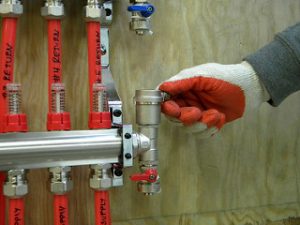Commercial Use of Radiant Heating Can Make Sense
 As an alternative to more traditional heating systems, radiant heating offers an efficient, clean and quiet way to keep your building warm and comfortable. Radiant heating systems have most commonly been used in residential settings, but they are gaining in popularity for use in commercial facilities. Here is a brief guide to radiant heating and why it can be an effective and money-saving choice for your office, retail sales outlet or manufacturing facility.
As an alternative to more traditional heating systems, radiant heating offers an efficient, clean and quiet way to keep your building warm and comfortable. Radiant heating systems have most commonly been used in residential settings, but they are gaining in popularity for use in commercial facilities. Here is a brief guide to radiant heating and why it can be an effective and money-saving choice for your office, retail sales outlet or manufacturing facility.
What is radiant heating?
Radiant heating is a comfort system that supplies heat directly to the room or area being heated. In the most common type of system, radiant floor heating, heat rises from the floor of the room. The heat is transferred to the occupants of the room through radiant heat transfer. At its simplest, a radiant floor heating system means you are working on a heated surface, much like an electric burner on a stove. The heat provided by radiant systems doesn’t get that severe, but it effectively keeps a building’s occupants comfortable even in very cold climates.
Common radiant heating configurations
- Radiant panel heating: Radiant panel heating uses aluminum panels attached to the room’s walls or ceiling to provide heat. These panels are heated by electricity or hot water and radiate heat outward and downward to provide room comfort. They are suitable options for heating rooms that are not used very often, for supplementing other heating systems or for heating areas where other options are not practical.
- Radiant floor heating: Radiant floor heating is by far the most common and efficient type of radiant system. Among radiant floor heating systems, hydronic heating is the most popular and energy-efficient style. In a hydronic system, heat is provided by pumping hot water produced by a boiler through a system of pipes embedded in the concrete of the room’s floor. The pipes can also be placed between two layers of plywood, located under the floor or subfloor, or embedded in a thin layer of concrete or gypsum placed on top of the existing floor. The hot-water pipes are arranged in a pattern that allows the maximum possible coverage for each part of the room, which helps prevent “cold spots” or areas of reduced heating.
Benefits of radiant heating
Radiant heating offers several practical benefits over traditional heating with furnaces or heat pumps, including improved energy efficiency, reduced cost of operation and clean, quiet function. Radiant floor heating systems also leave floors and walls free of intrusive or unsightly HVAC components
Considerations before installing radiant heating in commercial properties
- Additional heat loss: In a commercial establishment, there will be more heat loss to account for than in a residential setting. Larger open floor areas and heat losses through the building envelope must be considered.
- Air exchange and ventilation requirements: Manufacturing facilities or businesses that deal with paints, solvents, equipment or vehicle exhaust, or other types of chemicals and contaminants will need better ventilation. Since increased ventilation will also result in more indoor heat loss, this will need to be factored in during planning for a radiant heating system.
- Additional heating needs: The type of business you run may create a need for additional heating. For example, a business in which large doors such as those at loading docks are frequently opened will need more heat. Large pieces of cold machinery can increase heating demands, as can the frequent receipt of cold or refrigerated inventory or raw materials.
- Floor coverings: Some types of floor coverings are better for radiant floor heating systems. Ceramic tile and vinyl are two types of floor coverings that conduct heat well. Thin, non-plush carpeting with thin padding can also a good choice.
Our goal is to help educate our customers about Plumbing, HVACR, Fire Protection, and Alarm Systems in Mechanical, Commercial, and Residential settings. For more information about the radiant heating in commercial applications and to view projects we’ve worked on, visit our website!
Image Credit: PEX Tubing







